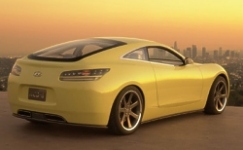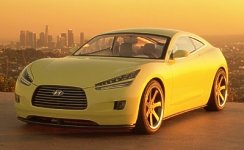
.
. .
..
. . . . .
Related Topics: © 1998 - 2006
Copyright & |
Hyundai Motor Company, Korea
Established in 1967, Hyundai Motor Co. has grown into the Hyundai Kia Automotive Group which includes over two dozen auto-related subsidiaries and affiliates. Employing over 50,000 people worldwide, Hyundai Motor posted US$20.8 billion in sales in 2003 (on a non-consolidated basis). Hyundai motor vehicles are sold in 193 countries through some 5000 dealerships and showrooms.
The early years of Hyundai Motors: The '70s: The Early Years Hyundai Motor Company was established in December 1967. The young automaker turned to Ford of the UK as its first partner to provide the requisite technology for cars and light trucks. This was a fruitful collaboration that led to enduring ties between the Korea and British auto industries. However, by the early 1970s, Hyundai management had made the critically important decision not to rely exclusively on foreign model licensing agreements but to simultaneously pursue the developments of its own proprietary passenger car. With styling input from Giorgio Giugiaro's ItalDesign and manufacturing know-how from Japan and the UK, Hyundai was able to put into production its first model, the Pony. The sub-compact was an immediate success in the domestic market and vaulted Hyundai into first place where it has remained unchallenged for over two decades. Export markets were tested during the latter 1970s and provided the company with early invaluable experience. The '80s: The boom Decade In the early 1980s, the company made another decision. Fueled by the momentum of rapid economic growth and supported by the efforts of dedicated, highly educated workforce, Hyundai invested in a major expansion of its Ulsan plant, making a major transition from low volume to high volume manufacturing. Hyundai was looking beyond the national border for future growth: The capacity would be divided between local market demand and serving export markets. By the mid 1980s, Hyundai had secured a solid beachhead in Canada and was ready to tackle the ultimate marketing challenge, the US market. During the latter 1980s, the company absorbed the lessons of playing in the major leagues of North America and prepared itself for the more intense competition that the 1990s would bring. By 1990, the company's cumulative exports to the US had surpassed one million units, a milestone that put Hyundai on the map. The '90s: The Pursuit of Technical Innovation and Higher Quality The 1990s saw a blossoming of Hyundai's decade-long commitment to developing its own technology. In 1991, the company unveiled its first in-house designed powerplant, the Alpha engine. Two years later, the Beta engine was unveiled. On the international rally circuit, the Hyundai Elantra claimed the Asia Pacific Rally Championship in its class in the 1994 and 1995 seasons, giving the company an encouraging start in professional motor sports. Hyundai Motor Company endured a difficult year in 1998, as domestic sales sharply declined. However, a succession of new models, starting with the EF Sonata and XG have earned Hyundai the highest accolades in the international automotive press and sustained exports combined with favorable export conditions have partially offset loss experienced in the domestic market. It was also a period of company-wise and industry-wise restructuring. The Kia/Asia Motors acquisition combined with the HPI and HMS mergers will allow Hyundai Motor to achieve the economies of scale needed to compete in the global market.
|
.
|





